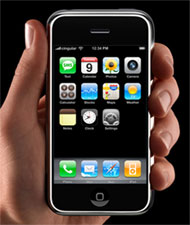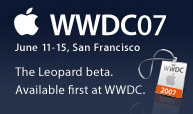iPhone: The Reviews are in and it's a Hit
 Yesterday media reviewers were finally allowed to post their writeups of their testing time with the iPhone, and overall the reviews are positive. While the iPhone isn't without it's shortcomings, it IS a 1.0 product so that's to be expected I guess. Overall, there are few surprises, which, considering the hype is GREAT for Apple.
Yesterday media reviewers were finally allowed to post their writeups of their testing time with the iPhone, and overall the reviews are positive. While the iPhone isn't without it's shortcomings, it IS a 1.0 product so that's to be expected I guess. Overall, there are few surprises, which, considering the hype is GREAT for Apple.Walt Mossberg et al starts out almost gushing over the thing:
We have been testing the iPhone for two weeks, in multiple usage scenarios, in cities across the country. Our verdict is that, despite some flaws and feature omissions, the iPhone is, on balance, a beautiful and breakthrough handheld computer. Its software, especially, sets a new bar for the smart-phone industry, and its clever finger-touch interface, which dispenses with a stylus and most buttons, works well, though it sometimes adds steps to common functions.
David Pogue at the New York Times is also really positive:
The phone is so sleek and thin, it makes Treos and BlackBerrys look obese. The glass gets smudgyóa sleeve wipes it cleanóbut it doesnít scratch easily. Iíve walked around with an iPhone in my pocket for two weeks, naked and unprotected (the iPhone, that is, not me), and thereís not a mark on it.
But the bigger achievement is the software. Itís fast, beautiful, menu-free, and dead simple to operate. You canít get lost, because the solitary physical button below the screen always opens the Home page, arrayed with icons for the iPhoneís 16 functions.
So how is entry with the "virtual" keyboard? For both reviewers, it's a non-issue. The Mossberg Solution:
The iPhone's most controversial feature, the omission of a physical keyboard in favor of a virtual keyboard on the screen, turned out in our tests to be a nonissue, despite our deep initial skepticism. After five days of use, Walt -- who did most of the testing for this review -- was able to type on it as quickly and accurately as he could on the Palm Treo he has used for years. This was partly because of smart software that corrects typing errors on the fly.
David Pogue:
...the instructional leaflet encourages you to ďtrustĒ the keyboard (or, as a product manager jokingly put it, to ďuse the ForceĒ). It sounds like new-age baloney, but it works; once you stop stressing about each individual letter and just plow ahead, speed and accuracy pick up considerably.
Not surprisingly, both reviewers found the AT&T EDGE network to be less than stellar, but praised the ability to connect using WIFI when available. David Pogue:
The New York Timesís home page takes 55 seconds to appear; Amazon.com, 100 seconds; Yahoo. two minutes. You almost ache for a dial-up modem.Ouch.
Some of the major and somewhat surprising shortcomings (for them, and for me) according to Pogue:
Thereís no memory-card slot, no chat program, no voice dialing. You canít install new programs from anyone but Apple; other companies can create only iPhone-tailored mini-programs on the Web. The browser canít handle Java or Flash, which deprives you of millions of Web videos. The two-megapixel camera takes great photos, provided the subject is motionless and well lighted . But it canít capture video. And you canít send picture messages (called MMS) to other cellphones.
A lot of these things are disappointing. While it's not something I'd use that much, video capture I figured would be a given, it was the only thing that made the whole YouTube on the iPhone thing make sense to me. Since you have no ability to capture and upload video, YouTube's only real purpose on the phone is to give you the ability to watch those stupid "skateboarding dog" videos where ever you are? Yeah that makes sense.
Pogue also mentions that a faster network is coming, but for NEW phones:
A future iPhone model will be able to exploit AT&Tís newer, much faster data network, which is now available in 160 cities.
So does that mean that our first-gen phones will be stuck with the EDGE network forever? I thought Apple said this would be a software upgrade? This is a bit troubling. Also troubling is the fact that the iPhone doesn't support SIM cards. Another interesting shortcoming is that there's also no way to cut, copy, or paste text. Hmmm. Version 1.0, just keep repeating that.
In addition to the glowing reviews from Mossberg and Pogue, there's lots of iPhone love coming from everywhere. Steven Levy reports for Newsweek:
The bottom line is that the iPhone is a significant leap. Itís a superbly engineered, cleverly designed and imaginatively implemented approach to a problem that no one has cracked to date: merging a phone handset, an Internet navigator and a media player in a package where every component shines, and the features are welcoming rather than foreboding. The iPhone is the rare convergence device where things actually converge
Levy also backs up my "why YouTube?" comment when he says "At launch, only a small percentage of the millions of video will have been reformatted to work with the phone. The fact is that YouTube without the long tail of hundreds of thousands of videos is barely worth the effort." So true.
Finally I'll add comments from USA Today's Ed Baig:
The mania over Apple's iPhone launch has created stratospheric expectations that are near impossible to live up to. Yet with a few exceptions, this expensive, glitzy wunderkind is indeed worth lusting after.
That's saying a lot. After months of hype, Apple has delivered a prodigy ó a slender fashion phone, a slick iPod and an Internet experience unlike any before it on a mobile handset.
I hope to post my own review here once I have an iPhone in my own hot little hands. I'll be in line here before the 6:00 AT&T store reopening. Things I'm personally looking forward to? Good email support, visual voice mail, good syncing and the video iPod support (I haven't upgraded to a color or video iPod yet).
Read more:
Mossberg: Testing Out the iPhone
Pogue: The iPhone Matches Most of Its Hype
Levy: At Last, the iPhone
Baig: Apple's iPhone isn't perfect, but it's worthy of the hype
Labels: Musings

 So you've got a cool software product for the Mac, and now you're looking for ways to either get exposure, or boost your sales. Well you could send out press releases, and send your news to Mac news sites, but this can be very hit or miss for a lot of us, especially when starting out. What do you do now?
So you've got a cool software product for the Mac, and now you're looking for ways to either get exposure, or boost your sales. Well you could send out press releases, and send your news to Mac news sites, but this can be very hit or miss for a lot of us, especially when starting out. What do you do now?









